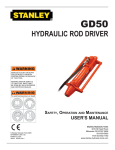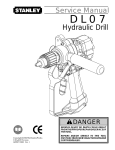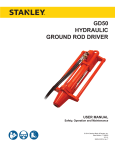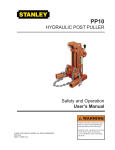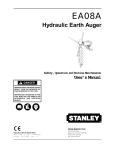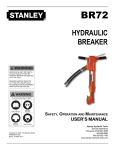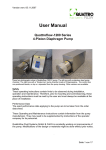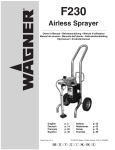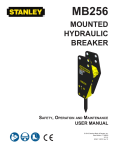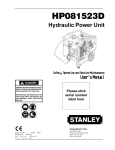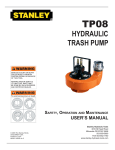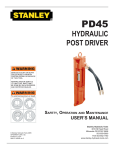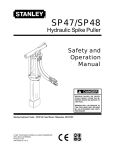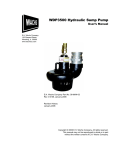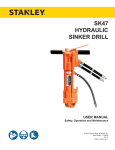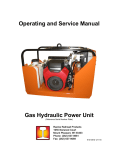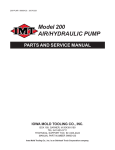Download GD50, 39234, Ops10-02 - Tool
Transcript
GD50 Hydraulic Rod Driver Safety ,Operation and Maintenance User's Manual SERIOUS INJURY OR DEATH COULD RESULT FROM THE IMPROPER REPAIR OR SERVICE OF THIS TOOL. REPAIRS AND / OR SERVICE TO THIS TOOL MUST ONLY BE DONE BY AN AUTHORIZED AND CERTIFIED DEALER. © 2000 THE STANLEY WORKS. All rights reserved OPS/MAINT USA VERSION Printed in U.S.A. 39234 Ver 3, 10/2002 Stanley Hydraulic Tools 3810 SE Naef Road Milwaukie, OR 97267-5698 USA Phone: (503) 659-5660 Fax: (503) 652-1780 SAFETY FIRST It is the responsibility of the operator and service technician to read rules and instructions for safe and proper operation and maintenance. A cautious worker using common sense is the greatest safety device COPYRIGHT© 2002 The Stanley Works. All rights reserved. Under copyright law, this document may not be copied in whole or in part without the prior written consent of The Stanley Works. This exception does not permit copies to be made for others, whether or not sold. Under the law, copying includes translating into another language, format, or medium. This copyright notice must appear on any permitted copies. CONTENTS Charging The Accumulator ...................................................................... 8 Hydraulic Hose Requirements ................................................................. 5 Hydraulic Requirements ........................................................................... 6 Operation ................................................................................................. 7 Parts Illustration ..................................................................................... 11 Parts List ................................................................................................ 12 Safety Precautions ............................................................................. 2 - 3 Special Service Tools ............................................................................. 10 Specifications ......................................................................................... 10 Tool Stickers and Tags ............................................................................. 4 Troubleshooting ....................................................................................... 9 Warranty ................................................................................................ 13 SERVICING GD50 Rod Drivers: This manual contains safety, operation, and routine maintenance instructions. Stanley Hydraulic Tools recommends that servicing of hydraulic tools, other than routine maintenance, must be performed by an authorized and certified dealer. Please read the following warning. SERIOUS INJURY OR DEATH COULD RESULT FROM THE IMPROPER REPAIR OR SERVICE OF THIS TOOL. REPAIRS AND / OR SERVICE TO THIS TOOL MUST ONLY BE DONE BY AN AUTHORIZED AND CERTIFIED DEALER. 1 SAFETY Tool operators and maintenance personnel must always comply with the safety precautions given in this manual and on the stickers and tags attached to the tool and hose. These safety precautions are given for your safety. Review them carefully before operating the tool and before performing general maintenance or repairs. Supervising personnel should develop additional precautions relating to the specific work area and local safety regulations. If so, place the added precautions in the space provided in this manual. GENERAL SAFETY PRECAUTIONS The GD50 Hydraulic Rod Driver will provide safe and dependable service if operated in accordance with the instructions given in this manual. Read and understand this manual and any stickers and tags attached to the tool and hoses before operation. Failure to do so could result in personal injury or equipment damage. • Operator must start in a work area without bystanders. The operator must be familiar with all prohibited work areas such as excessive slopes and dangerous terrain conditions. • Establish a training program for all operators to ensure safe operation. • Do not operate the tool unless thoroughly trained or under the supervision of an instructor. • Always wear safety equipment such as goggles, ear and head protection, and safety shoes at all times when operating the tool. • Do not inspect or clean the tool while the hydraulic power source is connected. Accidental engage ment of the tool can cause serious injury. • Always connect hoses to the tool hose couplers before energizing the hydraulic power source. Be sure all hose connections are tight. • Do not operate the tool at oil temperatures above 140°F/60°C. Operation at higher temperatures can cause higher than normal temperatures at the tool which can result in operator discomfort. • Do not operate a damaged, improperly adjusted, or incompletely assembled rod driver. • Do not weld, cut with an acetylene torch, or hardface the rod driver anvil or guide housing. • To avoid personal injury or equipment damage, all tool repair, maintenance and service must only be performed by authorized and properly trained personnel. • Always replace parts with replacement parts recommended by Stanley Hydraulic Tools. • Check fastener tightness often and before each use daily. 2 SAFETY Continued . . . SAFETY SYMBOLS Safety symbols are used to emphasize all operator, maintenance and repair actions which, if not strictly followed, could result in a life-threatening situation, bodily injury or damage to equipment. This safety symbol may appear on the tool. It is used to alert the operator of an action that could place him/her or others in a life threatening situation. This safety symbol appears in these instructions to identify an action that could cause bodily injury to the operator or other personnel. This safety symbol appears in these instructions to identify an action or condition that could result in damage to the tool or other equipment. Always observe safety symbols. They are included for your safety and for the protection of the tool. LOCAL SAFETY REGULATIONS Enter any local safety regulations here. Keep these instructions in an area accessible to the operator and maintenance personnel. 3 TOOL STICKERS & TAGS GD50 ROD DRIVER MODEL NUMBER LOCATION The information listed on the flow and pressure sticker must be legible at all times. Replace this sticker if it becomes worn or damaged. A replacement is available from your local Stanley distributor. Division of The Stanley Works StanleyHydraulicTools FLOW 26-34 LPM/7-9 GPM PRESS 105-140 BAR 1500-2000 PSI ACCUMULATOR CHG 42 BAR/600 PSI NITROGEN A nameplate sticker is attached to the spike driver on the cylinder below the handle. Never exceed the flow and pressure levels specified on this sticker. 37425 NAME TAG D A N G E R D A N G E R 1. FAILURE TO USE HYDRAULIC HOSE LABELED AND CERTIFIED AS NON-CONDUCTIVE WHEN USING HYDRAULIC TOOLS ON OR NEAR ELECTRICAL LINES MAY RESULT IN DEATH OR SERIOUS INJURY. BEFORE USING HOSE LABELED AND CERTIFIED AS NONCONDUCTIVE ON OR NEAR ELECTRIC LINES BE SURE THE HOSE IS MAINTAINED AS NON-CONDUCTIVE. THE HOSE SHOULD BE REGULARLY TESTED FOR ELECTRIC CURRENT LEAKAGE IN ACCORDANCE WITH YOUR SAFETY DEPARTMENT INSTRUCTIONS. 2. A HYDRAULIC LEAK OR BURST MAY CAUSE OIL INJECTION INTO THE BODY OR CAUSE OTHER SEVERE PERSONAL INJURY. The safety tag (p/n 15875) at right is attached to the tool when shipped from the factory. Read and understand the safety instructions listed on this tag before removal. We suggest you retain this tag and attach it to the tool when not in use. A DO NOT EXCEED SPECIFIED FLOW AND PRESSURE FOR THIS TOOL. EXCESS FLOW OR PRESSURE MAY CAUSE A LEAK OR BURST. B DO NOT EXCEED RATED WORKING PRESSURE OF HYDRAU LIC HOSE USED WITH THIS TOOL. EXCESS PRESSURE MAY CAUSE A LEAK OR BURST. C CHECK TOOL HOSE COUPLERS AND CONNECTORS DAILY FOR LEAKS. DO NOT FEEL FOR LEAKS WITH YOUR HANDS. CONTACT WITH A LEAK MAY RESULT IN SEVERE PERSONAL INJURY. D DO NOT LIFT OR CARRY TOOL BY THE HOSES. DO NOT ABUSE HOSE. DO NOT USE KINKED, TORN OR DAMAGED HOSE. 3. MAKE SURE HYDRAULIC HOSES ARE PROPERLY CONNECTED TO THE TOOL BEFORE PRESSURING SYSTEM. SYSTEM PRESSURE HOSE MUST ALWAYS BE CONNECTED TO TOOL "IN" PORT. SYSTEM RETURN HOSE MUST ALWAYS BE CONNECTED TO TOOL "OUT" PORT. REVERSING CONNECTIONS MAY CAUSE REVERSE TOOL OPERATION WHICH CAN RESULT IN SEVERE PERSONAL INJURY. 4. DO NOT CONNECT OPEN-CENTER TOOLS TO CLOSED-CENTER HYDRAULIC SYSTEMS. THIS MAY RESULT IN LOSS OF OTHER HYDRAULIC FUNCTIONS POWERED BY THE SAME SYSTEM AND/OR SEVERE PERSONAL INJURY. 5. BYSTANDERS MAY BE INJURED IN YOUR WORK AREA. KEEP BYSTANDERS CLEAR OF YOUR WORK AREA. 6. WEAR HEARING, EYE, FOOT, HAND AND HEAD PROTECTION. 7. TO AVOID PERSONAL INJURY OR EQUIPMENT DAMAGE, ALL TOOL REPAIR MAINTENANCE AND SERVICE MUST ONLY BE PERFORMED BY AUTHORIZED AND PROPERLY TRAINED PERSONNEL. I M P O R TA N T I M P O R TA N T READ OPERATION MANUAL AND SAFETY INSTRUCTIONS FOR THIS TOOL BEFORE USING IT. READ OPERATION MANUAL AND SAFETY INSTRUCTIONS FOR THIS TOOL BEFORE USING IT. USE ONLY PARTS AND REPAIR PROCEDURES APPROVED BY STANLEY AND DESCRIBED IN THE OPERATION MANUAL. USE ONLY PARTS AND REPAIR PROCEDURES APPROVED BY STANLEY AND DESCRIBED IN THE OPERATION MANUAL. TAG TO BE REMOVED ONLY BY TOOL OPERATOR. TAG TO BE REMOVED ONLY BY TOOL OPERATOR. SEE OTHER SIDE 15875 SAFETY TAG P/N 15875(shown smaller than actual size) 4 SEE OTHER SIDE 15875 HYDRAULIC HOSE REQUIREMENTS HOSE TYPES Hydraulic hose types authorized for use with Stanley Hydraulic Tools are as follows: ➊ Certified non-conductive ➋ Wire-braided (conductive) ➌ Fabric-braided (not certified or labeled non-conductive) Hose ➊ listed above is the only hose authorized for use near electrical conductors. Hoses ➋ and ➌ listed above are conductive and must never be used near electrical conductors. HOSE SAFETY TAGS To help ensure your safety, the following DANGER tags are attached to all hose purchased from Stanley Hydraulic Tools. DO NOT REMOVE THESE TAGS. If the information on a tag is illegible because of wear or damage, replace the tag immediately. A new tag may be obtained at no charge from your Stanley Distributor. D A N G E R D A N G E R 1 FAILURE TO USE HYDRAULIC HOSE LABELED AND CERTIFIED AS NON-CONDUCTIVE WHEN USING HYDRAULIC TOOLS ON OR NEAR ELECTRIC LINES MAYRESULT IN DEATH OR SERIOUS INJURY. FOR PROPER AND SAFE OPERATION MAKE SURE THAT YOU HAVE BEEN PROPERLY TRAINED IN CORRECT PROCEDURES REQUIRED FOR WORK ON OR AROUND ELECTRIC LINES. 2. BEFORE USING HYDRAULIC HOSE LABELED AND CERTIFIED AS NON-CONDUCTIVE ON OR NEAR ELECTRIC LINES. WIPE THE ENTIRE LENGTH OF THE HOSE AND FITTING WITH A CLEAN DRY ABSORBENT CLOTH TO REMOVE DIRT AND MOSISTURE AND TEST HOSE FOR MAXIMUM ALLOWABLE CURRENT LEAKAGE IN ACCORDANCE WITH SAFETY DEPARTMENT INSTRUCTIONS. 3. DO NOT EXCEED HOSE WORKING PRESSURE OR ABUSE HOSE. IMPROPER USE OR HANDLING OF HOSE COULD RESULT IN BURST OR OTHER HOSE FAILURE. KEEP HOSE AS FAR AWAY AS POSSIBLE FROM BODY AND DO NOT PERMIT DIRECT CONTACT DURING USE. CONTACT AT THE BURST CAN CAUSE BODILY INJECTION AND SEVERE PERSONAL INJURY. 4. HANDLE AND ROUTE HOSE CAREFULLY TO AVOID KINKING, ABRASION, CUTTING, OR CONTACT WITH HIGH TEMPERATURE SURFACES. DO NOT USE IF KINKED. DO NOT USE HOSE TO PULL OR LIFT TOOLS, POWER UNITS, ETC. 5. CHECK ENTIRE HOSE FOR CUTS CRACKS LEAKS ABRASIONS, BULGES, OR DAMAGE TO COUPLINGS IF ANY OF THESE CONDITIONS EXIST, REPLACE THE HOSE IMMEDIATELY. NEVER USE TAPE OR ANY DEVICE TO ATTEMPT TO MEND THE HOSE. 6. AFTER EACH USE STORE IN A CLEAN DRY AREA. SEE OTHER SIDE SEE OTHER SIDE 3 SIDE 1 D O N O T R E M O V E T H I S TA G D O N O T R E M O V E T H I S TA G The tag shown below is attached to "certified non-conductive" hose. (shown smaller than actual size) SIDE 2 D A N G E R D A N G E R 1 DO NOT USE THIS HYDRAULIC HOSE ON OR NEAR ELECTRIC LINES. THIS HOSE IS NOT LABELED OR CERTIFIED AS NON-CONDUCTIVE. USING THIS HOSE ON OR NEAR ELECTRICAL LINES MAY RESULT IN DEATH OR SERIOUS INJURY. 2. FOR PROPER AND SAFE OPERATION MAKE SURE THAT YOU HAVE BEEN PROPERLY TRAINED IN CORRECT PROCEDURES REQUIRED FOR WORK ON OR AROUND ELECTRIC LINES. 5. CHECK ENTIRE HOSE FOR CUTS CRACKS LEAKS ABRASIONS, BULGES, OR DAMAGE TO COUPLINGS IF ANY OF THESE CONDITIONS EXIST, REPLACE THE HOSE IMMEDIATELY. NEVER USE TAPE OR ANY DEVICE TO ATTEMPT TO MEND THE HOSE. 6. AFTER EACH USE STORE IN A CLEAN DRY AREA. 3. DO NOT EXCEED HOSE WORKING PRESSURE OR ABUSE HOSE. IMPROPER USE OR HANDLING OF HOSE COULD RESULT IN BURST OR OTHER HOSE FAILURE. KEEP HOSE AS FAR AWAY AS POSSIBLE FROM BODY AND DO NOT PERMIT DIRECT CONTACT DURING USE. CONTACT AT THE BURST CAN CAUSE BODILY INJECTION AND SEVERE PERSONAL INJURY. 4. HANDLE AND ROUTE HOSE CAREFULLY TO AVOID KINKING, CUTTING, OR CONTACT WITH HIGH TEMPERATURE SURFACES. DO NOT USE IF KINKED. DO NOT USE HOSE TO PULL OR LIFT TOOLS, POWER UNITS, ETC. SEE OTHER SIDE SEE OTHER SIDE SIDE 1 D O N O T R E M O V E T H I S TA G D O N O T R E M O V E T H I S TA G The tag shown below is attached to "conductive" hose. (shown smaller than actual size) SIDE 2 HOSE PRESSURE RATING The rated working pressure of the hydraulic hose must be equal to or higher than the relief valve setting on the hydraulic system. 5 HYDRAULIC SYSTEM REQUIREMENTS • The hydraulic system should provide a flow of 5-9 gpm/19-34 lpm at an operating pressure of 1500-2000 psi/105-140 bar. Recommended relief valve setting is 2100-2250 psi/145-155 bar. • The system should have no more than 250 psi/17 bar backpressure measured at the tool end of the operating hoses. The system conditions for measurement are at maximum fluid viscosity of 400 ssu/82 centistokes (minimum operating temperatures). • The hydraulic system should have enough heat rejection capacity to limit the maximum oil temperature to 140°F/60°C at the maximum expected ambient temperature. • The hydraulic system should have a minimum of 25 micron filtration. Stanley recommends using filter elements sized for a flow of at least 30 gpm/114 lpm for cold temperature startup and maximum dirt holding capacity. • The hydraulic fluid used should have a viscosity between 100 and 400 ssu/20 and 82 centistokes at the maximum and minimum expected operating temperatures. Petroleum base hydraulic fluids with antiwear properties and a viscosity index over 140 ssu/28 centistokes will meet the recommended requirements over a wide range of operating temperatures. • The recommended hose size is .500 inch/12 mm I.D. up to 50 ft/15 m long and .625 inch/16 mm I.D. minimum up to 100 ft/30 m long. • Quick disconnect couplings must conform to NFPA T3.20,15/EHTMA specifications. 6 OPERATION PREOPERATION Preparation For Initial Use Each unit as shipped has no special unpacking or assembly requirements prior to usage. Inspection to assure the unit was not damaged in shipping and does not contain packing debris is all that is required. PROCEDURES Check Hydraulic Power Source 1. Using a calibrated flowmeter and pressure gauge, check that the hydraulic power source develops a flow of 7-10 gpm/26-38 lpm for HTMA type II tools/EHTMA category D at 2000 psi/105-140 bar. 2. Make certain the hydraulic power source is equipped with a relief valve set to open at 2100-2250 psi/145155 bar minimum. 3. Check that the hydraulic circuit matches the tool for open-center (OC) operation. Check Tool 1. Make sure the tool contains the correct anvil for the rod size to be driven. Use the 5/8 inch anvil (standard in the model GD50132 & GD50132RF Rod Driver) for 5/8 inch diameter rod. Use the 1 inch anvil (standard in the model GD50133 & GD50133RF Rod Driver) for 3/4 inch to 1 inch diameter rod. Failure to use the correct anvil with the appropriate rod size can result in damage to the tool or personal injury. 1. Wipe all hose couplers with a clean lint-free cloth before making connections. 2. Connect the hoses from the hydraulic power source to the hose couplers on the rod driver. It is a good practice to connect the return hose first and disconnect it last to minimize or avoid trapped pressure within the rod driver. 3. Observe flow indicators stamped on hose couplers to be sure that oil will flow in the proper direction. The female coupler is the inlet coupler. NOTE: The pressure increase in uncoupled hoses left in the sun may result in making them difficult to connect. When possible, connect the free ends of operating hoses together. OPERATING PROCEDURES 1. Observe all safety precautions. 2. Move the hydraulic circuit control valve to the "ON" position. 3. Place the anvil of the rod driver over the rod to be driven. 4. Ensure adequate down pressure is applied to the rod driver before starting the rod driver. To start the rod driver, press the button on the control valve to the "ON" position. Adequate down pressure is very important. When you wish to stop the tool, press the button on the control valve to the "OFF" position. COLD WEATHER OPERATION 2. There should be no signs of leaks. 3. The tool should be clean, with all fittings and fasteners tight. Check Trigger Mechanism If the rod driver is to be used during cold weather, preheat the hydraulic fluid at low engine speed. When using the normally recommended fluids, fluid temperature should be at or above 50° F/10° C (400 ssu/82 centistokes) before use. 1. Check that the trigger operates smoothly and is free to travel between the "ON" and "OFF" positions. Connect Hoses 7 CHARGING THE ACCUMULATOR CHARGING THE ACCUMULA TOR ACCUMULATOR psi/42 bar. To check or charge the accumulator the following equipment is required: • Accumulator tester (Part Number 02835). • Charging assembly (Part Number 06545) (includes a regulator, hose and fitting). • NITROGEN bottle with a 800 psi/56 bar minimum charge. NOTE: It may be necessary to set the regulator at 650-700 psi/41-48 bar to overcome any pressure drop through the charging system. 6. Open the valve on the charging assembly hose. When the tester gauge reads 600-700 psi41-48 bar, close the valve on the charging assembly hose and remove the charging assembly. 7. Turn the gauge end of the tester fully counterclockwise to retract the plunger in the chuck. Remove the tester from the charge valve. 1. Holding the chuck end of the Stanley tester (p/n 02835), turn the gauge fully counterclockwise to ensure the stem inside the chuck is completely retracted. 8. Replace the valve cap. 2. Thread the tester onto the charging valve of the tool accumulator (do not advance the gauge-end into the chuck end. Turn as a unit). Seat the chuck on the accumulator charging valve by hand tightening only. TESTING THE ACCUMULA TOR PRES SURE ACCUMULATOR PRESSURE 3. Advance the valve stem by turning the gauge- end clockwise. 2. Read the pressure on the gauge. It should be between 500-700 psi/35-48 bar. 4. Connect the charging assembly to the valve on the tester. 3. If the pressure is low, recharge the tool. 1. Follow instructions 1 through 3 under "CHARGING THE ACCUMULATOR". 5. Adjust the regulator on the nitrogen bottle to 600 Regulator Nitrogen Tank 06545 ACCUMULATOR CHARGE KIT Includes: Regulator, hose and charge fitting. Hose w/ Charge Fitting Gauge Charging Valve Chuck 02835 TESTER 8 TROUBLESHOOTING If symptoms of poor performance develop, the following chart can be used as a guide to correct the problem. driver as listed in the table. Use a flowmeter known to be accurate. Check the flow with the hydraulic oil temperature at least 80°F/27°C. When diagnosing faults in operation of the spike driver, always check that the hydraulic power source is supplying the correct hydraulic flow and pressure to the spike Rod driver does not run. Rod driver does not hit effectively. Rod driver operates slow. Power unit not functioning. Check power unit for proper flow and pressure (7-10 gpm / 26-38 lpm, 2000 psi / 140 bar). Couplers or hoses blocked. Remove restriction. Presssure and return line hoses reversed at ports. Be sure hoses are connected to their proper ports. Mechanical failure of piston or automatic valve. Have inspected and repaired by authorized dealer. Power unit not functioning. Check power unit for proper flow and pressure (7-10 gpm / 26-38 lpm, 2000 psi / 140 bar). Couplers or hose blocked. Remove restriction, Low accumulator charge (pressure hose will pulse more than normal). Have recharged by authorized dealer. Fluid too hot (above 140° F / 60° C). Provide cooler to maintain proper fluid temperature. Rod Anvil is not sliding freely in the anvil guide. Remove, clean and replace as required. Low oil flow from power unit. Check power source for proper flow. High backpressure. Check hydraulic system for excessive backpressure and correct as required. 9 SPECIFICATIONS Capacity (Rod Anvil) 1/2 to 5/8 inch/12 to 16 mm diameter rod (model GD50132 & GD50132RF) 3/4 to 1 inch/19 to 25 mm diameter rod (model GD50133 & GD50133RF) Pressure Range ................................................................................................ 1500-2000 psi/105-140 bar Maximum Back Pressure ...................................................................................................... 250 psi/17 bar Flow Range .................................................................................................................. 5-9 gpm/19-34 lpm Couplers ........................................................................... HTMA/EHTMA Flush Face Type Male & Female Hose Whips ........................................................................................................................................... Yes Weight ...................................................................................................................... 57.3 lbs./26 kg Overall Length ............................................................................................................. 25.5 inches/64.8 cm Overall Width .................................................................................................................. 10 inches/25.4 cm Maximum Fluid Temperature ................................................................................................... 140° F/60° C SPECIAL TOOLS DESCRIPTION O-ring Tool Kit Split Rings Flow Sleeve Removal Tool Flow Sleeve Removal Tube Bearing Puller Kit Accumulator Disassembly Tool Tamper Sleeve Tool Accumulator Cylinder Puller 10 PART NUMBER 04337 04908 04919 04910 05064 05508 01120 05640 USAGE General Service of Seals Used with 04910 Flow Sleeve Removal Used with 04908 & 05508 General Bearing Pulling Used with 04910 Used to Pull Porting Block from Valve Block An Aluminum Disk (handy for protecting parts when using an arbor press 11 GD50 PARTS LIST Part No. Item GD50133RF Qty Description 1 2 3 4 5 6 7 8 9 10 11 12 13 14 15 16 17 18 19 20 21 22 23 24 25 26 27 28 29 30 31 32 33 34 35 36 37 38 39 40 41 42 43 44 45 46 GD50132 35770 370351 07493 ----20499 04374 15190 00720 07479 00293 15188 04058 11588 01605 350000 10536 04381 04379 09640 35784 07480 16070 01003 13568 13567 38631 00936 24059 24058 04382 04571 02900 37425 04383 09611 04605 19443 02022 03127 09642 34092 12139 35119 12143 12146 36106 GD50133 GD50132RF 35770 370351 07493 ----20499 04374 15190 00720 07479 00293 15188 04058 11588 01605 350000 10536 04381 04379 09640 35784 07480 16070 01003 13568 13567 38631 00936 24059 24058 04382 04571 02900 37425 04383 09611 04605 19443 02022 03127 09642 34092 12139 35119 12143 12146 35751 35770 370351 07493 05243 20499 04374 15190 00720 07479 00293 15188 04058 11588 01605 350000 10536 04381 04379 04378 35784 07480 16070 01003 13568 13567 38631 00936 24059 24058 04382 04571 02900 37425 04383 04384 04605 04954 02022 04387 04780 04386 12139 43527 12143 12146 36106 35770 370351 07493 05243 20499 04374 15190 00720 07479 00293 15188 04058 11588 01605 350000 10536 04381 04379 04378 35784 07480 16070 01003 13568 13567 38631 00936 24059 24058 04382 04571 02900 37425 04383 04384 04605 04954 02022 04387 04780 04386 12139 43527 12143 12146 35751 2 4 1 1 1 4 1 4 1 1 1 1 1 2 2 1 2 2 1 2 1 1 2 2 2 1 2 1 1 1 2 2 1 1 1 4 1 1 1 1 1 4 1 1 1 1 47 48 49 50 35752 35753 38629 00026 35752 35753 38629 00026 35752 35753 38629 00026 35752 35753 38629 00026 1 1 1 1 Handle Bar Capscrew O-Ring Plug-Male Orifice Plug (Included with Item 13) Charge Valve Lock Nut Top Plate Set Screw Diapragm O-ring Valve Spool Spring Accumulator Valve Block O-ring (Included with Item 15) Elbow, 45° (Included with item 14) Selector Screw Back-up Ring O-ring Porting Block Hose Assy Automatic Vavle Body Retaining Ring Valve Button Back-up Ring O-ring Valve Spool Adaptor Male Coupler Body Female Coupler Body Automatic Valve Push Pin Roll Pin Name Tag Flow Sleeve Tube Flow Sleeve Push Pin Piston O-ring Wiper Ring Back-up Washer Cup Seal Side Rod Adaptor Block Upper Anvil Stop Spring Rod Anvil, 5/8 inch rods (mdl GD50132) Rod Anvil, 3/4 to 1 inch rods (mdl GD50133) Anvil Guide Guide Housing Valve Body Assy. O-ring MODEL DESCRIPTIONS GD50132 - Rod Driver for 1/2 and 5/8 inch rods GD50133 - Rod Driver for 3/4 and 1 inch rods GD50132RF - Rod Driver for 1/2 and 5/8 inch rods GD50133RF - Rod Driver for 3/4 and 1 inch rods 12 CHECK TO MAKE SURE YOU HAVE THE CORRECT MODEL NUMBER BEFORE ORDERING 38632 O.C./C.C. Inline Control Valve Operating Instructions & Parts List The 38632 Inline Control Valve is designed to provide the ON/OFF functions for a hydraulic tool connected to either an OPEN CENTER (O.C.) hydraulic system or an CLOSED CENTER (C.C.) hydraulic system. The valve is to be used with tools which do not have an ON/OFF trigger control. The 38632 Control Valve can be used on hydraulic systems producing up to 10 gpm/38 lpm with a maximum relief valve setting of 2500 psi/172 bar. The valve ports are -8 SAE (3/4-16 thread) o-ring ports. Setting for Open Center (O.C.) or Closed Center (C.C.) Set the valve to O.C. or C.C. before connecting it to the hydraulic system. To set the valve for open center operation, use a straight blade screw driver to turn the selector screw counter clockwise until it stops. To set the valve for closed center operation, turn the selector screw clockwise until it stops. Be sure you know if you have an OPEN CENTER (O.C.) OR CLOSED CENTER (C.C.) hydraulic system, DO NOT attempt to install or operate the 38632 Valve until you do. Incorrect installation or operation of the valve can result in seal failures in the tool, cause excessive heat in the hydraulic system, and may damage the tool and hydraulic system. Understand which type of hydraulic system you are using before installing or operating this valve. Installing The Valve Connect the valve to the hydraulic system as shown in the illustration. Operating The Valve Connect the valve to the tool using the illustration below as a guide. Make sure the valve spool on the valve is pushed OFF before connecting the valve to the hydraulic system. Make sure the hydraulic system is OFF before connecting the valve to the hydraulic system. Connect the valve to the hydraulic system. Turn ON the hydraulic system. Place the tool to be operated in its operating position. Push the valve spool ON to begin operating the tool. Push the valve spool OFF to stop operating the tool. Turn the hydraulic system OFF before disconnecting the valve. Selector Screw Tool Hoses 38632 Valve 00936 Adapter Fittings Quick Disconnect Couplers IN (PRESSURE) OUT (RETURN) HYDRAULIC SYSTEM Instruction Sheet P/N 39716 13 WARRANTY Stanley Hydraulic Tools (hereinafter called “Stanley”), subject to the exceptions contained below, warrants new hydraulic tools for a period of one year from the date of sale to the first retail purchaser, or for a period of 2 years from the shipping date from Stanley, whichever period expires first, to be free of defects in material and/or workmanship at the time of delivery, and will, at its option, repair or replace any tool or part of a tool, or new part, which is found upon examination by a Stanley authorized service outlet or by Stanley’s factory in Milwaukie, Oregon to be DEFECTIVE IN MATERIAL AND/OR WORKMANSHIP. EXCEPTIONS FROM WARRANTY NEW PARTS: New parts which are obtained individually are warranted, subject to the exceptions herein, to be free of defects in material and/or workmanship at the time of delivery and for a period of 6 months after the date of first usage. Seals and diaphragms are warranted to be free of defects in material and/or workmanship at the time of delivery and for a period of 6 months after the date of first usage or 2 years after the date of delivery, whichever period expires first. Warranty for new parts is limited to replacement of defective parts only. Labor is not covered. FREIGHT COSTS: Freight costs to return parts to Stanley, if requested by Stanley for the purpose of evaluating a warranty claim for warranty credit, are covered under this policy if the claimed part or parts are approved for warranty credit. Freight costs for any part or parts which are not approved for warranty credit will be the responsibility of the individual. SEALS & DIAPHRAGMS: Seals and diaphragms installed in new tools are warranted to be free of defects in material and/or workmanship for a period of 6 months after the date of first usage, or for a period of 2 years from the shipping date from Stanley, whichever period expires first. CUTTING ACCESSORIES: Cutting accessories such as breaker tool bits are warranted to be free of defects in material and or workmanship at the time of delivery only. ITEMS PRODUCED BY OTHER MANUFACTURERS: Components which are not manufactured by Stanley and are warranted by their respective manufacturers. a. Costs incurred to remove a Stanley manufactured component in order to service an item manufactured by other manufacturers. ALTERATIONS & MODIFICATIONS: Alterations or modifications to any tool or part. All obligations under this warranty shall be terminated if the new tool or part is altered or modified in any way. NORMAL WEAR: any failure or performance deficiency attributable to normal wear and tear such as tool bushings, retaining pins, wear plates, bumpers, retaining rings and plugs, rubber bushings, recoil springs, etc. INCIDENTAL/CONSEQUENTIAL DAMAGES: To the fullest extent permitted by applicable law, in no event will STANLEY be liable for any incidental, consequential or special damages and/or expenses. FREIGHT DAMAGE: Damage caused by improper storage or freight handling. LOSS TIME: Loss of operating time to the user while the tool(s) is out of service. IMPROPER OPERATION: Any failure or performance deficiency attributable to a failure to follow the guidelines and/or procedures as outlined in the tool’s operation and maintenance manual. MAINTENANCE: Any failure or performance deficiency attributable to not maintaining the tool(s) in good operating condition as outlined in the Operation and Maintenance Manual. HYDRAULIC PRESSURE & FLOW, HEAT, TYPE OF FLUID: Any failure or performance deficiency attributable to excess hydraulic pressure, excess hydraulic back-pressure, excess hydraulic flow, excessive heat, or incorrect hydraulic fluid. REPAIRS OR ALTERATIONS: Any failure or performance deficiency attributable to repairs by anyone which in Stanley’s sole judgement caused or contributed to the failure or deficiency. MIS-APPLICATION: Any failure or performance deficiency attributable to mis-application. “Mis-application” is defined as usage of products for which they were not originally intended or usage of products in such a matter which exposes them to abuse or accident, without first obtaining the written consent of Stanley. PERMISSION TO APPLY ANY PRODUCT FOR WHICH IT WAS NOT ORIGINALLY INTENDED CAN ONLY BE OBTAINED FROM STANLEY ENGINEERING. WARRANTY REGISTRATION: STANLEY ASSUMES NO LIABILITY FOR WARRANTY CLAIMS SUBMITTED FOR WHICH NO TOOL REGISTRATION IS ON RECORD. In the event a warranty claim is submitted and no tool registration is on record, no warranty credit will be issued without first receiving documentation which proves the sale of the tool or the tools’ first date of usage. The term “DOCUMENTATION” as used in this paragraph is defined as a bill of sale, or letter of intent from the first retail customer. A WARRANTY REGISTRATION FORM THAT IS NOT ALSO ON RECORD WITH STANLEY WILL NOT BE ACCEPTED AS “DOCUMENTATION”. NO ADDITIONAL WARRANTIES OR REPRESENTATIONS This limited warranty and the obligation of Stanley thereunder is in lieu of all other warranties, expressed or implied including merchantability or fitness for a particular purpose except for that provided herein. There is no other warranty. This warranty gives the purchaser specific legal rights and other rights may be available which might vary depending upon applicable law. Stanley Hydraulic Tools • 3810 SE Naef Road • Milwaukie, Oregon 97267-5698 Ph 1-800-549-0517 • Fax 503-652-1780

















